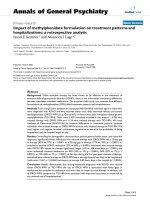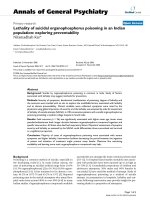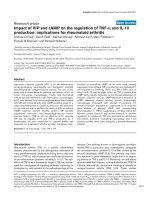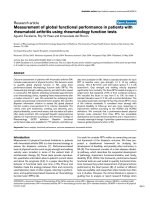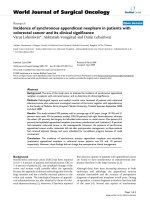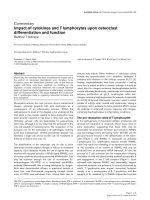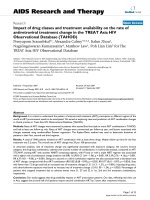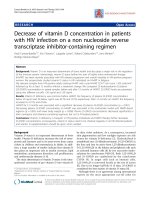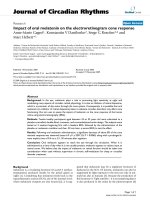Báo cáo y học: "Impact of intraoperative lung-protective interventions in patients undergoing lung cancer surgery" pot
Bạn đang xem bản rút gọn của tài liệu. Xem và tải ngay bản đầy đủ của tài liệu tại đây (144.11 KB, 10 trang )
Open Access
Available online />Page 1 of 10
(page number not for citation purposes)
Vol 13 No 2
Research
Impact of intraoperative lung-protective interventions in patients
undergoing lung cancer surgery
Marc Licker
1
, John Diaper
1
, Yann Villiger
1
, Anastase Spiliopoulos
2
, Virginie Licker
3
, John Robert
4
and Jean-Marie Tschopp
5
1
Department of Anaesthesiology, Pharmacology and Intensive Care, Faculty of Medicine, University of Geneva, rue Micheli-du-Crest, CH-1211
Geneva, Switzerland
2
Clinique des Grangettes and Faculty of Medicine, University of Geneva, CH-1224 Geneva, Switzerland
3
Biomedical Proteomics Group, Department of Structural Biology and Bioinformatics, Faculty of Medicine, University of Geneva, CH-1211 Geneva,
Switzerland
4
Department of Thoracic Surgery and Faculty of Medicine, University Hospital, CH-1211 Geneva, Switzerland
5
Department of Internal Medicine, Chest Medical Centre, CH-3960 Montana and Faculty of Medicine, University of Geneva, CH-1211 Geneva,
Switzerland
Corresponding author: Marc Licker,
Received: 27 Jan 2009 Revisions requested: 19 Feb 2009 Revisions received: 2 Mar 2009 Accepted: 24 Mar 2009 Published: 24 Mar 2009
Critical Care 2009, 13:R41 (doi:10.1186/cc7762)
This article is online at: />© 2009 Licker et al.; licensee BioMed Central Ltd.
This is an open access article distributed under the terms of the Creative Commons Attribution License ( />),
which permits unrestricted use, distribution, and reproduction in any medium, provided the original work is properly cited.
Abstract
Introduction In lung cancer surgery, large tidal volume and
elevated inspiratory pressure are known risk factors of acute
lung (ALI). Mechanical ventilation with low tidal volume has been
shown to attenuate lung injuries in critically ill patients. In the
current study, we assessed the impact of a protective lung
ventilation (PLV) protocol in patients undergoing lung cancer
resection.
Methods We performed a secondary analysis of an
observational cohort. Demographic, surgical, clinical and
outcome data were prospectively collected over a 10-year
period. The PLV protocol consisted of small tidal volume, limiting
maximal pressure ventilation and adding end-expiratory positive
pressure along with recruitment maneuvers. Multivariate
analysis with logistic regression was performed and data were
compared before and after implementation of the PLV protocol:
from 1998 to 2003 (historical group, n = 533) and from 2003
to 2008 (protocol group, n = 558).
Results Baseline patient characteristics were similar in the two
cohorts, except for a higher cardiovascular risk profile in the
intervention group. During one-lung ventilation, protocol-
managed patients had lower tidal volume (5.3 ± 1.1 vs. 7.1 ±
1.2 ml/kg in historical controls, P = 0.013) and higher dynamic
compliance (45 ± 8 vs. 32 ± 7 ml/cmH
2
O, P = 0.011). After
implementing PLV, there was a decreased incidence of acute
lung injury (from 3.7% to 0.9%, P < 0.01) and atelectasis (from
8.8 to 5.0, P = 0.018), fewer admissions to the intensive care
unit (from 9.4% vs. 2.5%, P < 0.001) and shorter hospital stay
(from 14.5 ± 3.3 vs. 11.8 ± 4.1, P < 0.01). When adjusted for
baseline characteristics, implementation of the open-lung
protocol was associated with a reduced risk of acute lung injury
(adjusted odds ratio of 0.34 with 95% confidence interval of
0.23 to 0.75; P = 0.002).
Conclusions Implementing an intraoperative PLV protocol in
patients undergoing lung cancer resection was associated with
improved postoperative respiratory outcomes as evidence by
significantly reduced incidences of acute lung injury and
atelectasis along with reduced utilization of intensive care unit
resources.
Introduction
Compared with other surgical procedures, thoracotomy is
associated with the highest 30-day mortality rates, ranging
from less than 1% for minor resections to up to 12% for pneu-
monectomies [1-3]. Postoperative onset of acute hypoxemia –
unrelated to cardiac failure, pulmonary embolism, atelectasis,
sepsis or bronchoaspiration – has attracted much interest as
it has become the leading cause of death in patients undergo-
ing lung resection [4,5]. The guidelines set forth by the Amer-
ican–European Consensus Conference on the acute
ALI: acute lung injury; ICU: intensive care unit; PaO
2
/FIO
2
ratio: oxygenation index, ratio of arterial oxygen pressure to inspired oxygen fraction; PBW:
predicted body weight; PEEP: positive end-expiratory pressure; PLV: protective lung ventilation; TNF: tumor necrosis factor; V
T
: tidal volume.
Critical Care Vol 13 No 2 Licker et al.
Page 2 of 10
(page number not for citation purposes)
respiratory distress syndrome have been widely adopted to
describe this form of acute lung injury (ALI), previously coined
postpneumonectomy pulmonary edema, low-pressure or low-
permeability pulmonary edema [6].
Contrasting with other adverse cardiopulmonary events, the
incidence of post-thoracotomy ALI has not shown any notice-
able decrease although various treatment modalities such as
noninvasive ventilation and nitric oxide inhalation have reduced
the case-fatality rate [7,8]. Interestingly, a large tidal volume
(V
T
) and an elevated inspiratory pressure during one-lung ven-
tilation have been identified as strong predictors of ALI in two
retrospective observational studies [9,10]. The hypothesis of
ventilator-induced lung injury during one-lung ventilation has
been further supported by the association between tidal vol-
ume exceeding 7 to 8 ml/kg predicted body weight (PBW)
and the release of systemic and pulmonary inflammatory medi-
ators [11]. Presently, the clinical benefits of lung-protective
strategies using lower V
T
combined with positive end-expira-
tory pressure (PEEP) have been clearly demonstrated in rand-
omized controlled trials including only critically ill patients with
ALI/acute respiratory distress syndrome [12].
Considering the potential injurious effects of large tidal volume
in patients with healthy lungs undergoing short-term one-lung
ventilation, we hypothesized that adopting a protective lung
ventilation (PLV) protocol as part of a collaborative quality
improvement initiative would lead to further reduction in the
incidence of post-thoracotomy ALI. In our institutional surgical
database, we examined whether protocol-driven changes in
ventilatory strategy initiated in 2003 were associated with bet-
ter clinical outcomes compared with historical controls.
Materials and methods
Study design and settings
The retrospective cohort study was approved by the Institu-
tional Research Board and included all consecutive cases of
lung cancer resection performed in two affiliated medical insti-
tutions: an academic center (Hôpitaux Universitaires de
Genève) and a tertiary reference hospital (Centre Valaisan de
Pneumologie in Sion). As the study concerned retrospective
analysis of data obtained during usual clinical practice, local
regulations do not require written informed consent. All
patients were operated on by one of two board-certified tho-
racic surgeons and were managed by the same team of cardi-
othoracic anesthesiologists.
Since 1 March 2003 the PLV strategy has been routinely
implemented as a best-practice model for intraoperative man-
agement (PLV cohort, from March 2003 to March 2008). This
PLV group entailed the application of low V
T
(< 8 ml/kg PBW),
pressure-controlled ventilation, limitation of the inspiratory pla-
teau pressure to 35 cmH
2
O, the addition of external PEEP (4
and 10 cmH
2
O) and performance of vital-capacity maneuvers
(raising the inspiratory pressure up to 35 cmH
2
O for 7 to 10
seconds) at 30-minute intervals.
In our database we abstracted a comparison group of nonpro-
tocolized consecutive patients undergoing operation during
the preceding 5 years (1998 to 2003), these patients being
referred as the historical control cohort. In this group, conven-
tional volume-targeted ventilation was aimed to achieve V
T
of
9 to 12 ml/kg PBW during two-lung ventilation and of 8 to 10
ml/kg PBW during one-lung ventilation while avoiding inspira-
tory pressure exceeding 35 cmH
2
O; no recruitment maneuver
was performed and PEEP was applied at the discretion of the
attending anesthesiologist.
In both groups, the same anesthetic workstations were used
(Dräger Primus or Zeus, Lübeck, Germany) with the respira-
tory rates and the oxygen inspiratory fraction adjusted to keep
the end-tidal carbon dioxide between 4 and 6 kPa (30 and 45
mmHg) and to keep the arterial pulsed oxygen saturation
above 90%.
The main outcome of interest was the development of ALI,
defined according to the American–European Consensus
Conference criteria as follows: sudden onset of respiratory
distress; infiltrates on the chest radiograph consistent with
pulmonary edema; impaired oxygenation with an arterial oxy-
gen pressure-to-inspired oxygen fraction ratio (PaO
2
/FIO
2
ratio) less than 300 mmHg for ALI; and absence of cardiac
insufficiency or fluid overload, based on pulmonary arterial
catheterization, echocardiogram and/or clinical evaluation [6].
Additional criteria for post-thoracotomy ALI included the onset
respiratory distress within the first 48 hours after surgery.
Patients presenting with aspiration of gastric contents, pneu-
monia, bronchopleural fistula or pulmonary embolism who later
developed noncardiogenic pulmonary edema were consid-
ered secondary ALI patients if they fulfilled the American–
European Consensus Conference criteria.
Secondary outcome variables were inhospital mortality, inten-
sive care unit (ICU) admissions, duration of hospital stay as
well as respiratory, cardiovascular and surgical complications
(see Additional data file 1).
In a previous study, we reported a 4.2% incidence of post-tho-
racotomy ALI [10]. A sample size of 1,000 operated patients
provided the power (80%) to detect a 50% relative risk reduc-
tion in post-thoracotomy ALI. The sample size therefore
resulted from an a priori decision to limit the analysis to two
consecutive periods, before and after implementing the PLV
strategy, including at least 500 patients per group.
Patients and perioperative management
Besides clinical evaluation, electrocardiography and labora-
tory screening, routine preoperative work-up included pulmo-
nary function tests (Sensor Medics, Yorba Linda, CA, USA)
Available online />Page 3 of 10
(page number not for citation purposes)
with the lung diffusion capacity to carbon monoxide, lung
biopsy, CT scan and/or positron emission tomography of the
chest and abdomen. Patients with borderline spirometric
results (forced expiratory volume in 1 second lower than 60%
to 80% of the predicted value), impaired exercise tolerance or
cardiac risk factors underwent complementary investigations
(peak oxygen consumption, differential lung perfusion/ventila-
tion scan, echocardiography, thallium myocardial scintigraphy
and/or coronary angiogram).
After anesthesia induction, a left-sided double-lumen tube was
inserted and its correct position was confirmed by fiberoptic
bronchoscopy. Lung resection with systematic lymph node
dissection was performed through an anterolateral muscle-
sparing thoracotomy. Thoracic epidural anesthesia was initi-
ated intraoperatively and continued postoperatively until
chest-drain removal.
Intraoperatively, intravenous crystalloids were infused at a rate
of 2 to 4 ml/kg/hour and blood losses were compensated with
colloids and with red blood cell concentrates if the hemo-
globin levels decreased below 80 to 90 g/l. All patients were
extubated in the operating theater and were admitted to an
intermediate care unit for at least 12 hours before being trans-
ferred to the surgical ward. During the first 48 hours after sur-
gery, aerosolized salbutamol and ipratropium were routinely
prescribed and a fluid balance of maximum 500 ml/day was
targeted, by limiting oral and intravenous fluid intakes. A
restrictive transfusion policy was adopted throughout both
study periods, with transfusion triggers ranging between 80
and 95 g/l. Antimicrobial prophylaxis with cefazoline was
administered for 24 hours.
Data collection
Demographic, clinical, surgical and anesthetic data as well as
perioperative complications were abstracted from a prospec-
tive registry including all patients who underwent thoracic sur-
gery. These data were collected by study nurses, entered into
the surgical database in the same manner during both study
periods and were cross-checked for accuracy. Before surgical
incision and 30 minutes after the start of one-lung ventilation,
the following ventilatory data were recorded: V
T
(ml/kg PBW),
inspiratory plateau pressure, PEEP and FIO
2
. The effective
dynamic compliance was obtained by dividing the ventilator-
delivered V
T
by the peak airway pressure minus the PEEP.
Intraoperatively and postoperatively, the use of vasopressor
drugs was recorded as well as the urine output and the
amount of fluid intake (colloids, crystalloids and blood prod-
ucts). On the first day after surgery, arterial oxygen pressure
(PaO
2
in kPa) was measured using a blood gas analyzer (ABL-
5 10 analyzer; Radiometer, Copenhagen, Denmark) and the
PaO
2
/FIO
2
ratio was calculated as the PaO
2
/FIO
2
ratio. Post-
operative complications were defined according to standard
criteria (see Additional data file 1).
Statistical analysis
For comparisons between the two cohorts, the unpaired Stu-
dent t test was used for normally distributed data and the
Mann–Whitney U test for non-normally distributed data. The
Kolmogorov–Smirnov test was applied to decide whether the
cohorts were normally distributed. The prevalence of risk fac-
tors and the incidence of complications in the two groups
were compared by Fisher exact test. Multivariate logistic
regression analysis using backward selection was performed
to assess whether demographic, clinical, laboratory and surgi-
cal factors, fluid and ventilatory management were associated
with the occurrence of primary ALI. We choose an inclusive
cutoff value for the empiric level of significance (P < 0.2) at
which we retained variables. The final model was assessed for
goodness of fit using the Hosmer–Lesmeshow test and for
omitted covariates and model misspecification using the link
test [13]. All analyses were performed using SPSS software
(version 14.0 for Microsoft Windows; SPSS, Chicago, IL,
USA) and statistical significance was specified as a two-tailed
type I error (P value) set below the 0.05 level.
Results
Over a 10-year period, 1,091 patients underwent pulmonary
resection for malignancy. Complete data were available in 533
patients from 1 March 1997 to 28 February 2003 and in 558
patients from 1 March 2003 to 28 February 2008.
As detailed in Table 1, baseline characteristics of patients
were similar between the two cohorts – except for a higher
cardiovascular risk profile in the PLV cohort, as evidenced by
a greater prevalence of hypertension and diabetes mellitus
along with more frequent prescription of cardiovascular drugs.
The type of surgery, the distribution of pathological cancer
stages, the need for chemoradiotherapy as well as the dura-
tion of one-lung ventilation and surgery did not differ between
the groups (Table 2). Fluid and vasopressor therapies were
also similar; however, a higher proportion of patients received
continuous thoracic epidural anesthesia in the PLV cohort
compared with the historical controls (98.2% vs. 92.3%, P <
0.05).
During one-lung ventilation V
T
< 8 ml/kg was achieved in 92%
of protocolized PLV patients (vs. 24% in historical controls),
resulting in significantly lower V
T
and inspiratory plateau pres-
sure, while the dynamic compliance, PEEP and respiratory rate
were significantly higher compared with the historical control
cohort (Table 3).
In the PLV cohort there was a reduction in the frequency of
post-thoracotomy ALI (from 3.7% to 0.9% in the historical
control cohort; P < 0.01) along with a lower incidence of atel-
ectasis, fewer admissions to the ICU and a shorter hospital
stay (Table 4). In the control cohort, patients ventilated with V
T
Critical Care Vol 13 No 2 Licker et al.
Page 4 of 10
(page number not for citation purposes)
Table 1
Preoperative characteristics of the two cohorts of thoracic surgical patients
Historical control cohort (n = 533) PLV cohort (n = 558) P value
Age 62 (12) 63 (12) 0.956
>70 years (%) 29 30 0.568
Gender, female (%) 35.6 36.9* 0.709
Body mass index (kg/m
2
) 25.1 (4.6) 25.3 (5.1) 0.567
Smoking (%)
Current 66.2 63.8 0.724
Ex-smoker (>6 months) 10.1 11.3 0.884
Alcohol (>60 g/day) 13.1 14.2 0.686
ASA classes 3 and 4 (%) 42.2 48.4* 0.047
Comorbidities (%)
Hypertension 24.4 35.1* < 0.01
Coronary artery disease 8.4 9.7* 0.546
Heart failure 5.8 8.7* 0.066
Hypercholesterolemia 16.7 22.9* 0.013
Peripheral artery disease 7.5 7.6 0.951
Diabetes mellitus 9.6 10.7 0.045
Arrythmia 2.1 2.7 0.633
Conduction blockade 8.4 7.3 0.576
Stroke 2.4 2.8 0.602
Prior PTCA/CABGS (%) 2.6 4.3 0.179
Preoperative medications (%)
β-Blockers 5.6 10.4* 0.006
ACE inhibitors/angiotensin II antagonists 11.1 16.5* 0.012
Statins 8.1 9.7 0.534
Corticoids 3.9 4.1 0.999
Antiplatelets 4.1 7.4* 0.032
Calcium channel blockers 3.7 4.1 0.874
Lung function
Forced vital capacity (l/min) 3.51 (1.07) 3.49 (0.96) 0.885
Forced vital capacity (% predicted value) 95 (21) 92 (22) 0.798
FEV1 (l/min) 2.5 (1.1) 2.4 (0.9) 0.825
FEV1 (% predicted value) 82 (18) 81 (19) 0.912
Total lung capacity (l/min) 6.2 (1.4) 6.3 (1.8) 0.892
Total lung capacity (% predicted value) 102 (18) 101 (17) 0.921
Carbon monoxide diffusion capacity (% predicted value) 54 (14) 53 (13) 0.896
Laboratory data
Hematocrit (%) 41.0 (5.1) 40.8 (4.9) 0.885
Creatinine clearance (ml/min) 83 (23) 85 (28) 0.387
Data presented as mean (standard deviation) or percentage. ACE, angiotensin-converting enzyme; ASA, American Society of Anesthesiologists;
CABGS, coronary artery bypass graft surgery; FEV1, forced expiratory volume in the first second; PLV, protective lung ventilation; PTCA,
percutaneous coronary angioplasty. *P < 0.05 between the two groups.
Available online />Page 5 of 10
(page number not for citation purposes)
Table 2
Perioperative surgical and medical characteristics
Historical control cohort (n = 533) PLV cohort (n = 558) P value
Preoperative chemotherapy 10.8 14.4 0.080
Type of surgery (% cases)
Pneumonectomy or bi-lobectomy 21.4 17.6 0.129
Lobectomy 54.2 56.1 0.575
Lesser resection 18.7 20.5 0.542
Explorative thoracotomy 5.4 3.2 0.099
Pathologic stage (% patients)
Ia and Ib 42 44 0.531
IIa and IIb 22 23 0.750
IIIa 18 19 0.733
IIIb and IV 11 8 0.389
Other 7 6 0.833
Thoracic epidural analgesia (% patients) 83.7 95.0* < 0.001
Intraoperative period
Duration of anesthesia (minutes) 166 (62) 176 (74) 0.228
Duration of surgery (minutes) 114 (47) 121 (56) 0.354
Duration of one-lung ventilation (minutes) 71 (18) 74 (20) 0.421
Total intraoperative fluid intake (ml/kg/hour) 5.6 (2.8) 5.8 (2.9) 0.587
Intravenous crystalloids (ml/kg/hour) 3.6 (1.4) 3.5 (1.6) 0.652
Intravenous colloids (ml/kg/hour) 2.0 (1.5) 2.3 (1.8) 0.187
Red blood cell transfusion (% patients) 1.50 1.61 0.991
Urine output (ml/kg/hour) 1.8 (1.2) 1.5 (1.4) 0.287
Phenylephrine (mg) 528 (443) 588 (487) 0.338
Ephedrine (mg) 15 (13) 16 (14) 0.542
Cumulative fluid intake (24 hours) (ml/kg/hour) 6.4 (3.2) 6.6 (3.1) 0.385
Postoperative period
Total fluid intake (ml/24 hours) 1,657 (573) 1,496 (608) 0.182
Red blood cell transfusion (% patients) 2.25 1.79 0.890
Urine output (ml/24 hours) 868 (334) 781 (234) 0.254
Chest drainage (ml/24 hours) 378 (172) 342 (125) 0.774
PaO
2
/FIO
2
(kPa) 45.1 (6.2) 44.7 (5.9) 0.513
Blood hemoglobin at POD1 (g/l) 119 (13) 121 (20) 0.834
Serum creatinine at POD1 (mg/l) 93 (30) 84 (31) 0.303
Data presented as mean (standard deviation), n (%) or percentage. PaO
2
/FIO
2
, ratio of arterial oxygen pressure to inspiratory fraction of oxygen;
PLV, protective lung ventilation; POD1, first postoperative day. *P < 0.05 between the two groups.
Critical Care Vol 13 No 2 Licker et al.
Page 6 of 10
(page number not for citation purposes)
< 8 ml/kg presented a trend for a lower rate of ALI (0.8% vs.
4.9% in patients ventilated with V
T
>8 ml/kg, P = 0.08).
The cause of death was primarily attributed to ALI in one out
of five patients in the PLV group (vs. 6/20 in the historical con-
trols), other causes being related to sepsis (2/5 vs. 4/20,
respectively), thromboembolism (1/5 vs. 3/20, respectively)
and myocardial infarct (1/5 vs. 1, respectively). Inhospital mor-
tality and the incidence of cardiovascular complications and
secondary ALI did not differ between the two groups.
When adjusted for baseline characteristics and perioperative
nonrespiratory management, the PLV intervention was associ-
ated with a decreased likelihood of ALI occurrence (adjusted
odds ratio = 0.34 with 95% confidence interval = 0.23 to
0.75; P = 0.002). As detailed in Table 5, multivariate logistic
regression analysis identified other independent risk factors
for ALI: the extent of lung resection (pneumonectomy,
adjusted odds ratio = 2.52 with 95% confidence interval =
1.34 to 7.71), V
T
(adjusted odds ratio = 1.17 per ml/kg
increase with 95% confidence interval = 1.02 to 1.26), alcohol
consumption (exceeding 60 g per day, adjusted odds ratio =
1.93 with 95% confidence interval = 1.14 to 5.71) and the
cumulated amount of perioperative fluid infused (adjusted
odds ratio = 1.42 per 1 ml/kg/hour increase with 95% confi-
dence interval = 1.09 to 4.32). There was no evidence that
additional covariates would improve the model (P = 0.21 by
the Wald link specification test). The c-index for this model
was 0.64 and the Hosmer–Lemeshow test for lack of fit was
not significant (P = 0.56).
Discussion
The present observational study is the first to indicate that
implementation of an intraoperative ventilatory strategy aimed
to limit lung overdistension while maintaining functional resid-
ual capacity with external PEEP and recruitment maneuvers
leads to significant reduction in the incidence of post-thoracot-
omy ALI and atelectasis along with fewer admissions to the
ICU and a shorter hospital stay.
Importantly, lowering the risk of ALI with PLV by more than
50% was independent of age, severity of underlying lung and
cardiovascular diseases as well as other perioperative inter-
ventions. Although the present results were obtained by com-
parison with a historical control group, they strongly suggest
that the PLV strategy may also benefit patients undergoing
lung cancer resection. Alternatively, the improved respiratory
outcome in PLV-treated patients supports the hypothesis that
ALI and atelectasis may in part be caused by or be related to
intraoperative factors: ventilator-induced lung injury or ventila-
tor-associated injuries and the reduction of functional residual
capacity consequent to the effects of surgical insults, anesthe-
sia and muscle paralysis [14,15]. High shear stress associ-
ated with cyclic opening of collapsed areas (atelectotrauma)
Table 3
Intraoperative Ventilatory management
Historical control cohort (n = 533) PLV cohort (n = 558)
Two-lung ventilation
Tidal volume (ml/kg predicted body weight) 9.2 (2.8) 6.5 (2.0)*
Patients with tidal volume < 8 ml/kg (%) 24 92 *
Inspiratory plateau pressure (cmH
2
O) 16 (5) 12 (4)*
Positive end-expiratory pressure (cmH
2
O) 3 (2) 3 (3)
Dynamic compliance (ml/cmH
2
O) 52.4 (9.1) 53.5 (8.7)
Inspiratory oxygen fraction (%) 40 (4) 38 (13)
Respiratory rate (cycle/minute) 11 (1) 14 (2)*
One-lung ventilation
Tidal volume (ml/kg predicted body weight) 7.1 (1.2) 5.3 (1.1)*
Inspiratory plateau pressure (cmH
2
O) 20 (7) 15 (6)*
Positive end-expiratory pressure (cmH
2
O) 3.3 (2.1) 6.2 (2.4)*
Dynamic compliance (ml/cmH
2
O) 32.2 (7.5) 44.6 (6.9)*
Inspiratory oxygen fraction (%) 64 (9) 67 (8)
Respiratory rate (cycle/minute) 13 (2) 15 (2)*
Data presented as mean (standard deviation) or percentage. *P < 0.05 between the two groups.
Available online />Page 7 of 10
(page number not for citation purposes)
and deformation of the alveolar epithelium (strain) during one-
lung ventilation are thought to generate a proinflammatory
state (biotrauma) leading to pulmonary tissue alterations.
By the late 1990s the standard V
T
for managing thoracic sur-
gical patients had already been adjusted downwards (from 10
to 12 ml/kg in the 1980s) to 8 to 10 ml/kg, although no spe-
cific guidelines existed for one-lung ventilation. Our historical
control data were consistent with these values and, after
implementation of the PLV protocol, the V
T
declined from
mean values of 7.1 to 5.3 ml/kg during the one-lung ventilation
period. We used predicted rather than actual body weight for
calculating the V
T
per kilogram of body weight to avoid lung
overdistension in obese patients and in women who have
smaller lung volumes [16]. Importantly, the ventilatory end-
points (V
T
< 8 ml/kg and inspiratory plateau pressure < 35
cmH
2
O) were achieved in more than 80% of patients. Compli-
ance with the new ventilatory guidelines was facilitated by the
relatively short ventilatory time (< 3 hours), the absence of
acute critical illnesses and the commitment of a small number
of cardiothoracic anesthesiologists. Interestingly, similar pro-
tective ventilatory strategies applied in ICU settings have been
associated with a decreased incidence of ALI in high-risk
patients, although the target V
T
was achieved in only 50% to
60% of cases [17-19].
Thoracic surgical candidates represent a particular group of
noncritically ill patients in whom ventilation-induced cytokine
upregulation produces a proinflammatory state that renders
the host more vulnerable to subsequent hit(s) such as
ischemia–reperfusion, hypoxia–reoxygenation and direct tis-
sue trauma [20-22]. Depletion of pulmonary glutathione stores
observed in alcoholic patients is expected to further exacer-
bate oxidative lung injuries [23].
To date, three randomized controlled trials including patients
undergoing thoracotomy have compared the application of tra-
ditional high V
T
with the open lung strategy combining low V
T
and PEEP. Although Wrigge and colleagues failed to docu-
ment any difference in systemic inflammatory markers [24],
Schilling and colleagues found reduced alveolar concentra-
tions of TNFα and soluble intercellular adhesion molecules in
patients ventilated with small V
T
(5 vs. 10 ml/kg) [25]. Confirm-
ing these positive results, Michelet and colleagues reported an
attenuated systemic proinflammatory response, lower intersti-
tial pulmonary edema and an improved oxygenation index
Table 4
Postoperative outcomes of patients undergoing lung cancer resection
Historical control cohort (n = 533) PLV cohort (n = 558) P value
Length of hospital stay (days) 14.5 (3.3) 11.8 (4.1)* < 0.001
Admission to the intensive care unit (%) 9.4 2.5* < 0.001
Mortality (%) 2.8 2.3 0.753
Reoperation (%) 1.0 1.6 0.687
Respiratory complications (%) 14.4 10.8 0.080
Atelectasis 8.8 5.0* 0.018
Pneumonia 5.6 4.1 0.309
Bronchopleural fistula 1.5 1.3 0.873
Acute lung injury 3.8 0.9* 0.032
Pneumonectomy 10.7 3.1 0.094
Lobectomy, bi-lobectomy 1.7 0.2 0.174
Lesser resection 3.8 0.7 0.282
Mechanical ventilation >24 hours 4.1 3.5 0.379
Cardiovascular complications (%) 12.0 11.3 0.723
Myocardial infarct 1.3 0.9 0.711
Heart failure 0.9 1.4 0.635
Stroke 0.8 0.7 0.951
Arrhythmia's 11.8 10.4 0.514
Renal dysfunction 5.1 3.0 0.123
Data presented as mean (standard deviation) or percentage. *P < 0.05 between the two groups; χ
2
test with Yates correction or unpaired Student
t test.
Critical Care Vol 13 No 2 Licker et al.
Page 8 of 10
(page number not for citation purposes)
allowing earlier extubation in the protective ventilation group
among patients undergoing esophagectomy [26].
In the present study we adopted a PLV including pressure-
controlled ventilation, external PEEP and recruitment maneu-
vers. Actually, delivery of a decelerating gas flow has been
reported to achieve more homogeneous flow distribution and
lower peak airway pressure [27]. Different lung recruitment
strategies have been shown to re-expand the collapsed
dependent lung areas that develop in almost all anesthetized
patients. During thoracic surgery, application of recruitment
maneuvers with moderate PEEP levels to the dependent lung
has been shown to improve oxygenation and to reduce both
intrinsic PEEP levels and static elastance of the respiratory
system without causing significant cardiovascular deteriora-
tion [28]. Our data confirm the good hemodynamic tolerance
to the PLV protocol since fluid and vasopressor requirements
were similar in the two cohorts. Given the difficulties in con-
structing static pressure–volume curves, we did not titrate the
PEEP but we set a fixed moderate level of PEEP that could
potentially cause alveolar hyperinflation in healthy or emphyse-
matous areas. This possibility seems unlikely since we
observed higher compliance in patients managed with the PLV
protocol, which supports the stabilizing effects of PEEP along
with effective re-expansion of previously collapsed areas fol-
lowing recruitment maneuvers [29-31].
We acknowledge several limitations in the current study.
Although data were collected by clinicians and validated by
scientific investigators, we assume variability in initial ventilator
settings with the possibility that higher inspiratory pressures
and tidal volume were deliberately chosen to correct transient
hypoxemia and hypercapnia. The observational design limits
the ability to infer causality between the lung-protective proto-
col and lowering the incidence of ALI. Although statistics were
helpful to adjust for some confounding variables, unmeasured
factors and other changes in practice or in the patient case mix
may have decreased the confidence in observed effects. For
instance, potentially beneficial therapies such as preoperative
statin and angiotensin-converting enzyme treatment, continu-
ous thoracic epidural anesthesia, goal-directed fluid therapy
using transesophageal Doppler monitoring, inhalation of β
2
-
agonists in high-risk patients, and early postoperative mobiliza-
tion were popularized during the postintervention period, and
thereby could have contributed to the overall reduction in res-
piratory complications and in hospital length of stay [32]. On
the other hand, despite higher prevalence of hypertension in
the protocol-treated cohort, mortality and cardiovascular
adverse events were unchanged compared with the control
cohort. Finally, major limitations also stem from the definition of
ALI that may cover different clinical patterns and histological
findings, which may explain significant interobserver diagnos-
tic disagreement particularly in postoperative patients [33]. In
the present study, we excluded patients with delayed onset of
ALI triggered by infection, bronchial aspiration of gastric con-
tent and allogenic transfusion. Accordingly, post-thoracotomy
ALI probably identified a more homogeneous group of patients
predisposed to the injurious effects of mechanical ventilation.
Table 5
Variables associated with post-thoracotomy acute lung injury
Characteristic Unadjusted analysis Adjusted analysis
Odds ratio (95% confidence interval) P value Odds ratio (95% confidence interval) P value
Age, per 10-year increase 1.09 (0.80 to 1.89) 0.382 - -
Chronic alcohol consumption 1.76 (1.11 to 5.2) 0.013 1.93 (1.14 to 5.71) 0.001
FEV1 < 60% 1.12 (0.78 to 2.05) 0.254 - -
ASA class 3/4 1.21 (0.72 to 2.21) 0.214 - -
ACE inhibitor therapy 0.85 (0.55 to 2.12) 0.315 - -
Statin therapy 0.81 (0.45 to 2.97) 0.198 - -
Chemo-radiotherapy 1.52 (1.09 to 3.83) 0.021 1.40 (0.91 to 2.98) 0.203
Advanced TNM stages (III to IV) 1.63 (1.09 to 3.01) 0.018 1.45 (0.87 to 2.84) 0.234
Thoracic epidural anesthesia 0.92 (0.78 to 1.92) 0.563 - -
Duration of surgery 1.37 (0.78 to 2.67) 0.312 - -
Red blood cell transfusion 1.09 (0.23 to 7.24) 0.789 - -
Pneumonectomy 2.41 (1.29 to 8.12) 0.005 2.52 (1.34 to 7.71) < 0.001
Fluid infused, per 1 ml/kg/hour increase 1.33 (1.02 to 5.08) 0.032 1.42 (1.09 to 4.32) 0.011
ACE, angiotensin-converting enzyme; ASA, American Society of Anesthesiologists; FEV
1
, forced expiratory volume in 1 second; TNM, Tumor,
Node, Metastasis.
Available online />Page 9 of 10
(page number not for citation purposes)
The reliability of ALI diagnostic criteria could have been
improved by additional measurements of plasma brain natriu-
retic factor and lung water content with the transpulmonary
thermodilution technique [34,35].
Conclusions
In this observational study, we demonstrated the effectiveness
of combining low V
T
, PEEP and recruitment maneuvers. This
intraoperative open-lung approach was easily implemented in
clinical practice and resulted in a reduced incidence of post-
operative ALI and atelectasis. Implementation of a bundle of
scientifically-based perioperative interventions represents an
integral component of clinical quality management. Future clin-
ical trials will determine whether optimization of other ventilator
settings (for example, oxygen inspiratory fraction, PEEP level,
periodicity of recruitment maneuver) may improve respiratory
outcome in specific groups of surgical patients requiring
mechanical ventilation.
Competing interests
The authors declare that they have no competing interests.
Authors' contributions
ML and J-MT participated in the study design, data analysis
and interpretation of the data as well as the writing of the man-
uscript. JD, VL and ML participated in the data collection and
statistical analysis. JD, YV and JR participated in the literature
search and interpretation of the study. AS and JR participated
in revising the bibliography, and correcting and editing the
manuscript. All authors read and approved the final manu-
script.
Additional files
Acknowledgements
The Lancardis Fundation in Sion (Switzerland) granted support for this
study. No source influenced the study design, data collection, analysis,
reporting, or decision to submit the manuscript for publication.
References
1. Boffa DJ, Allen MS, Grab JD, Gaissert HA, Harpole DH, Wright
CD: Data from The Society of Thoracic Surgeons General Tho-
racic Surgery database: the surgical management of primary
lung tumors. J Thorac Cardiovasc Surg 2008, 135:247-254.
2. Memtsoudis SG, Besculides MC, Zellos L, Patil N, Rogers SO:
Trends in lung surgery: United States 1988 to 2002. Chest
2006, 130:1462-1470.
3. Goodney PP, Lucas FL, Stukel TA, Birkmeyer JD: Surgeon spe-
cialty and operative mortality with lung resection. Ann Surg
2005, 241:179-184.
4. Alam N, Park BJ, Wilton A, Seshan VE, Bains MS, Downey RJ,
Flores RM, Rizk N, Rusch VW, Amar D: Incidence and risk fac-
tors for lung injury after lung cancer resection. Ann Thorac
Surg 2007, 84:1085-1091.
5. Licker MJ, Widikker I, Robert J, Frey JG, Spiliopoulos A, Ellen-
berger C, Schweizer A, Tschopp JM: Operative mortality and
respiratory complications after lung resection for cancer:
impact of chronic obstructive pulmonary disease and time
trends. Ann Thorac Surg 2006, 81:1830-1837.
6. Bernard GR, Artigas A, Brigham KL, Carlet J, Falke K, Hudson L,
Lamy M, LeGall JR, Morris A, Spragg R: Report of the American-
European consensus conference on ARDS: definitions, mech-
anisms, relevant outcomes and clinical trial coordination. The
Consensus Committee. Intensive Care Med 1994, 20:225-232.
7. Licker M, Fauconnet P, Villiger Y, Tschopp JM: Acute lung injury
and outcomes after thoracic surgery. Curr Opin Anaesthesiol
2009, 22:61-67.
8. Tang SS, Redmond K, Griffiths M, Ladas G, Goldstraw P, Dusmet
M: The mortality from acute respiratory distress syndrome
after pulmonary resection is reducing: a 10-year single institu-
tional experience. Eur J Cardiothorac Surg 2008, 34:898-902.
9. Fernandez-Perez ER, Keegan MT, Brown DR, Hubmayr RD, Gajic
O: Intraoperative tidal volume as a risk factor for respiratory
failure after pneumonectomy. Anesthesiology 2006,
105:14-18.
10. Licker M, de Perrot M, Spiliopoulos A, Robert J, Diaper J, Chevalley
C, Tschopp JM: Risk factors for acute lung injury after thoracic
surgery for lung cancer.
Anesth Analg 2003, 97:1558-1565.
11. Schultz MJ: Lung-protective mechanical ventilation with lower
tidal volumes in patients not suffering from acute lung injury:
a review of clinical studies. Med Sci Monit 2008,
14:RA22-RA26.
12. Petrucci N, Iacovelli W: Lung protective ventilation strategy for
the acute respiratory distress syndrome. Cochrane Database
Syst Rev 2007:CD003844.
13. Vittinghoff EGD, Shibosky SC, McCulloch CE: Regression meth-
ods in biostatistics: linear, logistic, survival, and repeated
measures of models. Springer New York; 2005:72-93.
Key messages
• Intraoperative application of a small tidal volume, PEEP
and recruitment maneuvers was successfully achieved
in 92% patients undergoing lung cancer resection over
a 5-year period.
• Adoption of the presented lung ventilatory strategy was
associated with a reduced incidence of acute lung
injury (0.9% vs. 3.7%) and atelectasis (5% vs. 8.8%),
and with fewer admissions to the ICU (2.5% vs. 9.4%)
and a shorter length of hospital stay (11.8 ± 4.1 vs.
14.5 ± 3.3 days).
• Traditional intraoperative ventilatory settings can be
harmful, and therefore new guidelines should be pro-
posed.
The following Additional files are available online:
Additional file 1
A word file containing a table that lists the major nonfatal
complications occurring during the inhospital
postoperative stay. Standard criteria are used to define
these adverse events.
See />supplementary/cc7762-S1.doc
Critical Care Vol 13 No 2 Licker et al.
Page 10 of 10
(page number not for citation purposes)
14. Hedenstierna G, Edmark L: The effects of anesthesia and mus-
cle paralysis on the respiratory system. Intensive Care Med
2005, 31:1327-1335.
15. Kozian A, Schilling T, Freden F, Maripuu E, Rocken C, Strang C,
Hachenberg T, Hedenstierna G: One-lung ventilation induces
hyperperfusion and alveolar damage in the ventilated lung: an
experimental study. Br J Anaesth 2008, 100:549-559.
16. Steinberg KP, Kacmarek RM: Respiratory controversies in the
critical care setting. Should tidal volume be 6 mL/kg predicted
body weight in virtually all patients with acute respiratory fail-
ure? Respir Care 2007, 52:556-564.
17. Yilmaz M, Keegan MT, Iscimen R, Afessa B, Buck CF, Hubmayr
RD, Gajic O: Toward the prevention of acute lung injury: proto-
col-guided limitation of large tidal volume ventilation and inap-
propriate transfusion. Crit Care Med 2007, 35:1660-1666.
18. Davis JL, Morris A, Kallet RH, Powell K, Chi AS, Bensley M, Luce
JM, Huang L: Low tidal volume ventilation is associated with
reduced mortality in HIV-infected patients with acute lung
injury. Thorax 2008, 63:988-993.
19. Umoh NJ, Fan E, Mendez-Tellez PA, Sevransky JE, Dennison CR,
Shanholtz C, Pronovost PJ, Needham DM: Patient and intensive
care unit organizational factors associated with low tidal vol-
ume ventilation in acute lung injury. Crit Care Med 2008,
36:1463-1468.
20. Kuzkov VV, Suborov EV, Kirov MY, Kuklin VN, Sobhkhez M,
Johnsen S, Waerhaug K, Bjertnaes LJ: Extravascular lung water
after pneumonectomy and one-lung ventilation in sheep. Crit
Care Med 2007, 35:1550-1559.
21. Cheng YJ, Chan KC, Chien CT, Sun WZ, Lin CJ: Oxidative stress
during 1-lung ventilation. J Thorac Cardiovasc Surg 2006,
132:513-518.
22. Meier T, Lange A, Papenberg H, Ziemann M, Fentrop C, Uhlig U,
Schmucker P, Uhlig S, Stamme C: Pulmonary cytokine
responses during mechanical ventilation of noninjured lungs
with and without end-expiratory pressure. Anesth Analg 2008,
107:1265-1275.
23. Joshi PC, Guidot DM: The alcoholic lung: epidemiology, patho-
physiology, and potential therapies. Am J Physiol Lung Cell
Mol Physiol 2007, 292:L813-L823.
24. Wrigge H, Uhlig U, Zinserling J, Behrends-Callsen E, Ottersbach
G, Fischer M, Uhlig S, Putensen C: The effects of different ven-
tilatory settings on pulmonary and systemic inflammatory
responses during major surgery. Anesth Analg 2004,
98:775-781.
25. Schilling T, Kozian A, Huth C, Buhling F, Kretzschmar M, Welte T,
Hachenberg T: The pulmonary immune effects of mechanical
ventilation in patients undergoing thoracic surgery. Anesth
Analg 2005, 101:957-965.
26. Michelet P, D'Journo XB, Roch A, Doddoli C, Marin V, Papazian L,
Decamps I, Bregeon F, Thomas P, Auffray JP: Protective ventila-
tion influences systemic inflammation after esophagectomy: a
randomized controlled study. Anesthesiology 2006,
105:911-919.
27. Unzueta MC, Casas JI, Moral MV: Pressure-controlled versus
volume-controlled ventilation during one-lung ventilation for
thoracic surgery. Anesth Analg 2007, 104:1029-1033.
28. Cinnella G, Grasso S, Natale C, Sollitto F, Cacciapaglia M, Angi-
olillo M, Pavone G, Mirabella L, Dambrosio M: Physiological
effects of a lung-recruiting strategy applied during one-lung
ventilation. Acta Anaesthesiol Scand 2008, 52:766-775.
29. Farias LL, Faffe DS, Xisto DGMC, Lassance R, Prota LF, Amato
MB, Morales MM, Zin WA, Rocco PR: Positive end-expiratory
pressure prevents lung mechanical stress caused by recruit-
ment/derecruitment. J Appl Physiol 2005, 98:53-61.
30. Slinger PD, Kruger M, McRae K, Winton T: Relation of the static
compliance curve and positive end-expiratory pressure to oxy-
genation during one-lung ventilation. Anesthesiology 2001,
95:1096-1102.
31. Pavone L, Albert S, DiRocco J, Gatto L, Nieman G: Alveolar insta-
bility caused by mechanical ventilation initially damages the
nondependent normal lung. Crit Care 2007, 11:R104.
32. Licker M, Tschopp JM, Robert J, Frey JG, Diaper J, Ellenberger C:
Aerosolized salbutamol accelerates the resolution of pulmo-
nary edema after lung resection for cancer. Chest 2008,
133:845-852.
33. Phua J, Stewart TE, Ferguson ND: Acute respiratory distress
syndrome 40 years later: time to revisit its definition. Crit Care
Med 2008, 36:2912-2921.
34. Monnet X, Anguel N, Osman D, Hamzaoui O, Richard C, Teboul JL:
Assessing pulmonary permeability by transpulmonary ther-
modilution allows differentiation of hydrostatic pulmonary
edema from ALI/ARDS. Intensive Care Med 2007, 33:448-453.
35. Karmpaliotis D, Kirtane AJ, Ruisi CP, Polonsky T, Malhotra A, Tal-
mor D, Kosmidou I, Jarolim P, de Lemos JA, Sabatine MS, Gibson
CM, Morrow D: Diagnostic and prognostic utility of brain natri-
uretic peptide in subjects admitted to the ICU with hypoxic
respiratory failure due to noncardiogenic and cardiogenic pul-
monary edema. Chest 2007, 131:964-971.
